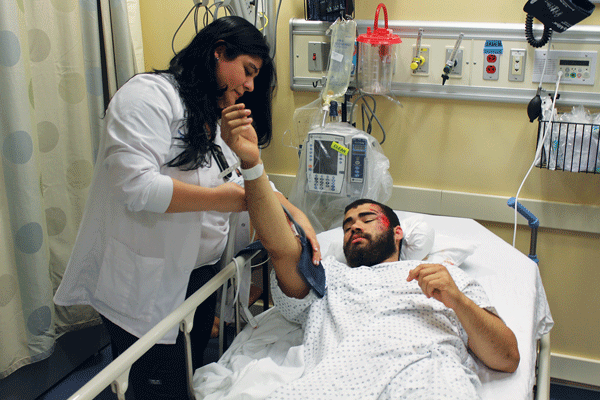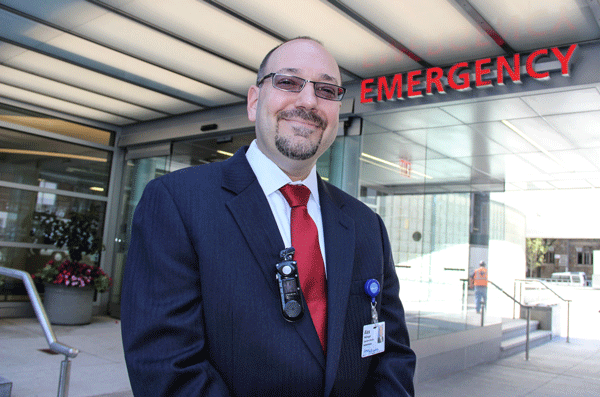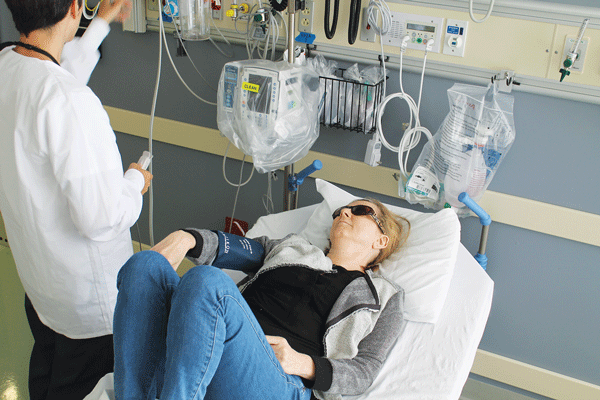
BY LINCOLN ANDERSON | David Baez woke up under a staircase in front of the Search & Destroy punk shop on St. Mark’s Place last Thursday morning. The left side of his head was a mess of bloody scrapes.
“I had all this crap on my face,” he said. “I don’t remember what happened.”
He got on his lime-green track bike — which he somehow had had the presence of mind to lock up nearby before winding up under the stairs — and pedaled over to the new Lenox Hill HealthPlex freestanding emergency department, at W. 12th St. and Seventh Ave.
He was in luck. It was the E.D.’s opening day.
“I knew this place was here,” he said. “But I didn’t know if it was open yet.”
He knew the HealthPlex would be opening sometime soon, since he works right around the corner as a dispatcher at Juice Press, on Greenwich Ave. (which, he proudly noted, is even better than Liquiteria, “way more raw, way more organic”).
Baez, 22, spoke Thursday around 1 p.m. as he was lying on a bed in one of the HealthPlex’s 26 private rooms for patients. In fact, he was the West Village’s new healthcare facility’s very first patient.

The place had opened its doors at 10 a.m, but it took a little while before patients started arriving — and when they did, it was in a surge, 10 patients in the space of an hour and a half. That’s typically how it happens, noted Dr. Eric Cruzen, the HealthPlex’s emergency medical director. Eight of the patients were still at the HealthPlex when The Villager arrived, two having been treated and released.
Baez said the last thing he remembered from the previous night was unlocking his bike outside 3 Sheets Saloon, on W. Third St., where he had been drinking, and saying goodbye to his cousin. He was planning to bike home to Sunset Park, Brooklyn — his usual commute.
“I honestly don’t know how I ended up on St. Mark’s Place,” he said. “I was very drunk,” he admitted. “I didn’t realize how drunk I was.”
Asked what he thought about the treatment he was receiving at the HealthPlex, Baez good-naturedly said, without missing a beat, “Excellent. Honestly, they’re very nice people. Very sociable. Very easy to speak to if you have an issue. Very nonjudgmental.”
He was being kept for observation for a while. The HealthPlex would also make sure he’d have follow-up care, which is very important in the case of such an injury, especially where it wasn’t known exactly how hard he may have hit his head.
Local critics, distraught over the loss of St. Vincent’s, which was a full-service hospital, have blasted the 24/7 stand-alone E.D. — which doesn’t have inpatient hospital beds as part of the facility — as an “urgent-care center on steroids.” Yet, it offers a higher level of emergency care than an urgent-care center.
For example, Baez was given a CAT scan to check for skull fractures or any bleeding in his brain — a capability that urgent-cares don’t have.
And the HealthPlex will treat anyone, regardless of his or her ability to pay.
All of the walk-in patients on Thursday up to that point had had zero wait time to be seen. Other patients had come in for migraines, abdominal pains and high blood pressure, among other things.
A Jane St. resident, 47, had glass, or possibly some other object, lodged under his toe that he got while playing soccer on the beach in Brazil.
A Village restaurant worker who lives in the Bronx, 18, had cut the tip off the top of his thumb while chopping asparagus. He came, got three stitches, and was released.
A firecracker of upbeat energy, nurse Amy Smith is the HealthPlex’s project manager. She said she really liked the HealthPlex’s layout, since it allows her to keep an eye on multiple patients in various rooms at once. She noted she could, at that moment, easily see a patient about 40 feet away who was resting in a room, who had fainted and fallen and didn’t know where he was.
“That’s serious,” she said.
In fact, that man was the HealthPlex’s first patient brought in by ambulance — by an ambulance from North Shore-LIJ Health System, the HealthPlex’s umbrella health group.

Speaking in very limited English, Melvin Morales, 23, explained that he works in a market — apparently in Midtown — and was in Grand Central Station when he fainted.
He was hooked up to a heart monitor, and they were doing blood work on him.
“He looks good,” said Smith, who then asked him if he had eaten anything for breakfast. He had not. That could very well have been a factor, she noted, but they would continue the testing.
As for why the ambulance brought Morales to the HealthPlex in the Village, Cruzen explained that it’s an algorithm of the emergency responders’ decision, plus a computer that tells them where the best available treatment option is.
No patients had yet been transported by ambulance to local hospitals for higher-level care, such as would be done for acute heart attacks or strokes or major trauma, like a serious gunshot wound.
Also resting in a bed after getting treatment was Cathy Casrielgyory, from Horatio St., who had been suffering a severe migraine and vertigo as a result of a debilitating bout of Meniere’s disease, an inner-ear affliction.
She had been getting herself psyched up to take a taxi ride through crosstown traffic over to N.Y.U. Langone Medical Center in the E. 30s on First Ave., but then — even though she wasn’t sure if it was open yet — she decided to walk over to the HealthPlex.
They gave her intravenous valium, for which she was grateful.
“I feel better, not 100 percent, so they’re sending me home with some valium,” she said, wearing sunglasses to block out the light and help calm her symptoms, as her daughter sat nearby, having accompanied her over to the HealthPlex.
Another thing the HealthPlex can do that an urgent-care center can’t, is dispense a wide variety of medications to its patients.
A nurse came in and checked her blood pressure.
“One hundred fifty-four over 76,” she said, “a little high for your baseline, but not high for the E.R.”
Casrielgyory’s assessment of the care she had received?
“Great,” she said. “Very prompt. The place is full of spirit today. And as a resident of the neighborhood, I’m glad to have it back,” she said of the healthcare facility. “If I have an attack like this, I will come back.”
As The Villager was leaving the HealthPlex — the patients in good hands with the medical staff — Kelly Gates, 24, was entering , being greeted by the front-desk staff, and preparing to get treated by a staff member for what Gates believed to be bedbug bites. She expressed incredulity that she lives in the West Village, yet could possibly have bedbugs.
A week earlier, officials with North Shore-L.I.J. and the HealthPlex, and even the neighboring L.G.B.T. Community Center, had formally dedicated the facility at an opening ceremony.
Afterward, Assemblymember Deborah Glick gave the new HealthPlex her seal of approval, and said she especially liked that it has a special section — with a separate entrance — for sexual-assault victims. The area is set up to provide the greatest privacy to the victims, and also to set them at ease.
“Women in the community need to know that there’s a separate, private entrance for victims of sexual assault,” she said, adding, “That is just an indication of the way they have thought this through from the patients’ point of view.”
TPIA, a clot buster given to stroke victims, is available at the facility, Glick added.
Over all, she was very bullish on the HealthPlex.
“Very much so,” she said, “and I think the community will look forward to the imaging services and specialty care” that will be added in the near future in the building’s upper floors.
N.S.-LIJ poured $150 million into the facility — the former St. Vincent’s O’Toole Building — which will be offering more medical services in the near future beyond just the E.D., the latter, admittedly, which was the main aspect of St. Vincent’s that the community feared losing when the historic hospital closed.
There hadn’t been any protest action recently by diehard advocates of a full-service hospital who had savaged the freestanding E.D., which ultimately wasn’t surprising, she said.
“You’re going to come here and say how this is terrible for the community?” Glick said. “You’re going to have access to up-to-date emergency healthcare.”

















